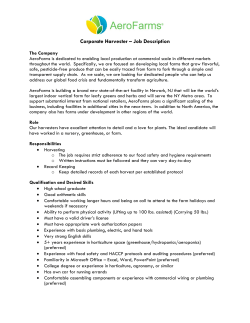
the possible effects of the cap reform on farm employment in
THE POSSIBLE EFFECTS OF THE CAP REFORM ON FARM EMPLOYMENT IN HUNGARY SÁNDOR ELEK ∗, IMRE FERTŐ ∗∗, CSABA FORGÁCS *** ABSTRACT We analyse the possible impacts of CAP reform on farm employment in a lagged rural region in Hungary using survey among the farmers. Our results shows that farmers are rather pessimistic on the employment effects of CAP reform, they expect the decrease of farm job irrespective to its type. Econometric analyses suggest that size of farms in terms area positively related to the expected number of male employment on the farms, whilst the less favored land has negative effects on the male employment except seasonal workers. Farms employing more labour expect that number of full time female workers will slightly increase, whilst the number of part-time and seasonal workers will decrease. Less favoured area has negative impact on the expected job for seasonal workers. In general, farmers expectations is contradict to the intention of CAP reform. Keywords: CAP reform, farm employment, Hungary. 1 INTRODUCTION The one of the main aims of the agricultural policy is to create complementary or alternative income and employment opportunities for farmers and their families, on-farm and off-farm. Hungary joined to the European Union in 2004, thus the application of the CAP in Hungary yields a new situation for Hungarian farmers. There were many expectations among farmers, but after two years they evaluate more realistic their situation under the CAP. In addition, first experiences of Hungarian farmers on the CAP may affect their perception on the possible impacts of the CAP reform between 2007 and 2013. Although there is wealth of literature on ∗ Corvinus University of Budapest, Department of Agricultural Economics and Rural Development, E-mail: sandor.elek@uni-corvinus.hu ∗∗ Institute of Economics, Hungarian Academy of Sciences, Budapest, Hungary, E-mail: ferto@econ.core.hu *** Corvinus University of Budapest, Department of Agricultural Economics and Rural Development, E-mail: csaba.forgacs@uni-corvinus.hu Poster Paper presented at IAMO Forum 2008 2 the effects of CAP reform using various approaches, but research on farm employment in transition countries is still limited. The paper tries to contribute to the literature at least two ways. First, contrary to previous research focusing on rather ex post effects of CAP reform, this paper concentrate on the impacts in future based on farmers’ perception. Second, our research is one of the first to deal with impacts of recent CAP reform. The goal of the paper is to investigate the possible effects of the CAP reform on the level of farm employment in a traditional agricultural region of Hungary. More specifically, we focus on the Southern Great Plain, where agriculture and related industries have always played very important role in the regional economy and rural employment. We are interesting how agricultural policy may help to maintain the farm jobs in lagged rural region. 2 GEOGRAPHICAL AND ECONOMICAL CHARACTERISTICS OF THE SOUTHERN GREAT PLAIN REGION The Southern Great Plain, the largest (NUTS2) region in the country, is located in the South and South-east of Hungary. The region consists of three (NUTS3) counties (Bács-Kiskun, Békés, and Csongrád) [See Figure 1]. Despite its declining share, agriculture is dominant in the regional economy. Although, the Southern Great Plain accounts for only 9% of the total Gross Domestic Product (GDP) of Hungary, it accounts for 25% of the agricultural GDP. Agriculture’s share of the regional GDP was 9% in 2002. About 62% (965 000 hectares) of the region’s arable land was cultivated by private holdings in 2000 (the year of the Agricultural Census). The Southern Great Plain’s economic structure differs from the national average, particularly in the agricultural and service sectors. Industry’s share in regional and national GVA is about equal but regionally agriculture is over-represented by 6.7%, and services are underrepresented by 5% compared to the national figures. The per capita GDP for the Hungarian regions, with the exception of Central Hungary, achieved only 75% of EU average in 2002, the Southern Great Plain was at 40.4% of the EU average in terms of per capita GDP (on PPS) which put the Southern Great Plain at 242 out of the 254 regions comprising the EU. In the period between 1995 and 2003 the Southern Great Plain region had the lowest economic growth rate in Hungary. However differences in net average income are not as significant as the differences in GDP. The net average income of workers employed in the Southern Great Plain was 87% of the national average in 2003. The Possible Effects of the CAP Reform on Farm Employment in Hungary 3 Figure 1: NUTS3 regions of Hungary Source: Central Statistical Office (KSH) Note: Dél-Alföld = Southern Great Plain The employment rate for people aged 15-64 in Hungary (56.9% in 2005) corresponds with the average employment rate in the ten new member states. However, it is significantly lower than the rate of 64% for EU-15. In 2004 the Southern Great Plain’s employment rate for those aged 15-64, was 47.3%, compared to the national rate of 50.6%. In Hungary the low employment rate is not coupled with a high unemployment rate because of the high number of disability pensioners who are under retirement age. The region’s has a strong agricultural character the proportion of agricultural employment is the highest of all regions. Besides this, the ratio of people involved in the sector in some way (e.g. part-time farming or seasonal work) is 21.7%, second highest in the country behind the Northern Great Plain. 3 SURVEY DESIGN AND VARIABLES Our research based on a survey among farmers in Southern Great Plain. We ask the respondents on their perceptions about the possible impacts of the CAP reform on farm employment, namely how many people will work on theirs farm in seven years. The total number of observations is 400. After cleaning of the data, final sample contains 333 observations. Table 1 present summary statistics on the variables. The average area of farms was 56.2 hectare, and the mean area of less favoured land amounted to 10.2 hectare. The average number of total employment including part-time and seasonal workers is relatively high (56 persons). About Poster Paper presented at IAMO Forum 2008 4 80 per cent of farmers run the farm as family farm, and the share of part-time farm was about 26 per cent. The 13 per cent of farm owners is female. The respondents’ perceptions show a pessimistic view on the possible impacts of the CAP reform on the farm employment. They expect that number of employment will decrease after seven years regardless to type and gender of farm labour, except part-time male farm workers. Interestingly, farmers expect the largest decrease in seasonal workers following by full-time workers and part-time workers irrespective to the gender. However, the expected fall in employment is higher for female for part-time and seasonal workers. Table 1: Descriptive statistics of variables Variable N Total land (ha) 333 56.16 92.38 0 659 LFA land (ha) 333 10.24 43.21 0 546 Age (1-5) 333 2.95 1.07 1 5 Education (1-3) 333 1.92 0.63 1 3 Part-time farm 333 0.26 0.44 0 1 Family farm 333 0.79 0.41 0 1 Female 333 0.13 0.33 0 1 Labour 333 56.16 92.38 1 66 Change in full time male worker 333 -0.07 1.66 -9 12 Change in part-time male worker 333 0.00 1.08 -8 10 Change in seasonal male worker 333 -0.17 1.32 -10 5 Change in full time female worker 333 -0.04 1.21 -9 8 Change in part-time female worker 333 -0.08 0.85 -9 2 Change in seasonal female worker 333 -0.26 1.37 -10 5 Source: 4 Mean Std. Dev. Min Max own estimations based on the survey……. RESULTS We focus on the possible impacts of CAP reform on farm employments. Thus, we construct a variable for employment change comparing actual employment to expected employment situations. We can hypothesize that socio-economic factors of farmers can explain their perceptions for changes in farm employment. More specifically, we expect that total land size of farms (LAND), education level of farmers (EDUC), and age of farmers (AGE) is positively The Possible Effects of the CAP Reform on Farm Employment in Hungary 5 related to the farmers’ perception, whilst being a part-time farm (PTIME), and size of less favoured land (LFA) affects negatively on their decisions. We do not have a priori expectation on the effects of number of labour (LABOUR). The impacts of labour can be positive similar logic to farm size in terms of total land. However, the higher level of employment level also may result a decrease due to technical changes enforced by various agricultural policy measurements. Finally, we test the following model: Emplchange=α0+ α1LAND+ α2LFA+ α3AGE+ α4EDUC+ α5PTIME+ α6LABOUR (1) The expected signs of the variables are as follows: α1>0, α2<0, α3>0, α4>0 α5<0 and α6<0. We estimate our model for each type of labour separately. Table 2: Estimations for expected male employment changes full time part-time seasonal LAND 0.005*** 0.002*** 0.002*** LFA -0.007*** -0.003* 0.003* AGE 0.098 -0.056 -0.000 EDUC -0.182 0.104 -0.106 PTIME 0.053 0.167 0.047 LABOUR 0.023 -0.003 -0.095*** CONSTANT -0.330 -0.158 0.194 R2 0.1156 0.0302 0.1718 F test (p value) 0.000 0.1228 0.000 N 333 333 333 Note :* p<0.1; ** p<0.05; *** p<0.01 Our results suggest that the size of farms in terms area significantly related to the expected number of male employment on the farms in seven years regardless to the type of farm job (Table 2). However, the size of less favored land has negative and significant effects on the male employment except seasonal workers. The education level and age of farm leader and being part-time farm have not significant impacts on expected farm employment. Farms with more workers have negative effects on possible job for seasonal workers. Estimations for female workers produce poor results in terms of statistical significance. The size of labour is only significant for all estimations. Farmers with more labour expect that number of full time female workers will slightly increase, whilst the number of part-time and Poster Paper presented at IAMO Forum 2008 6 seasonal workers will decrease. Less favoured area has negative impact on the expected job for seasonal workers. Table 3: Estimations for expected female employment changes full time part-time seasonal LAND 0.000 0.000 0.001 LFA -0.001 -0.000 -0.005*** AGE -0.001 -0.048 0.007 EDUC -0.087 -0.006 -0.148 PTIME 0.015 -0.073 -0.035 LABOUR 0.036*** -0.027*** -0.097*** CONSTANT -0.005 0.171 0.329 R 0.0398 0.0346 0.1656 F test (p value) 0.0222 0.0729 0.0000 N 333 333 333 2 Note :* p<0.1; ** p<0.05; *** p<0.01 CONCLUSIONS We analyse the possible impacts of CAP reform on farm employment in a lagged rural region in Hungary using survey among the farmers. Our results shows that farmers evaluate less optimistic the employment effects of CAP reform. In general, they expect the decrease in farm jobs irrespective to its type. Econometric analyses suggest that only the larger farms believe that they will increase their employments, especially for males. In addition, the situations for part-time and seasonal workers probably will become worse comparing to full-time farmers. The expected chance to get a job for males is also better than females. Farming in less favoured areas has negative effects on the possible farm employment. In short, farmers expectations are contradict to the intention of CAP reform. ACKNOWLEDGEMENTS The authors thank to financial support to the CARRERA project financed by the EU 6th framework.
© Copyright 2025








